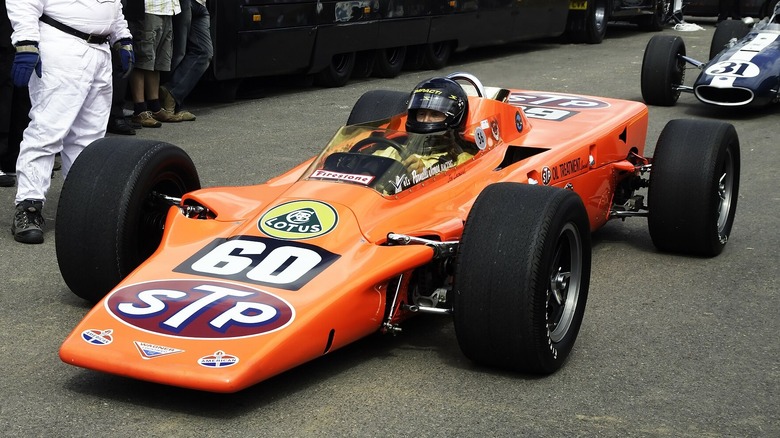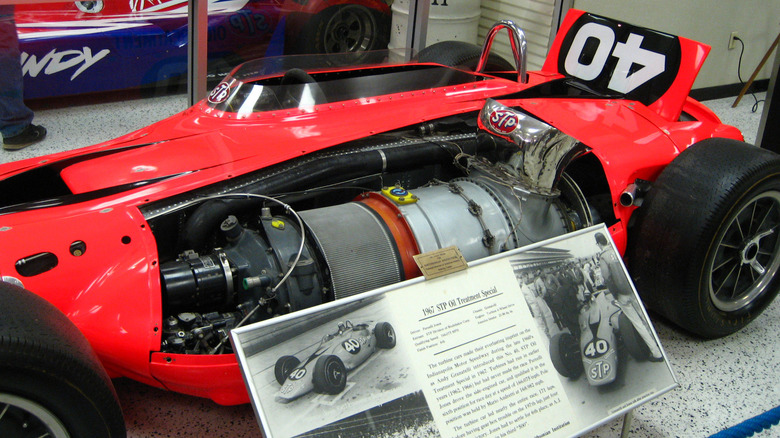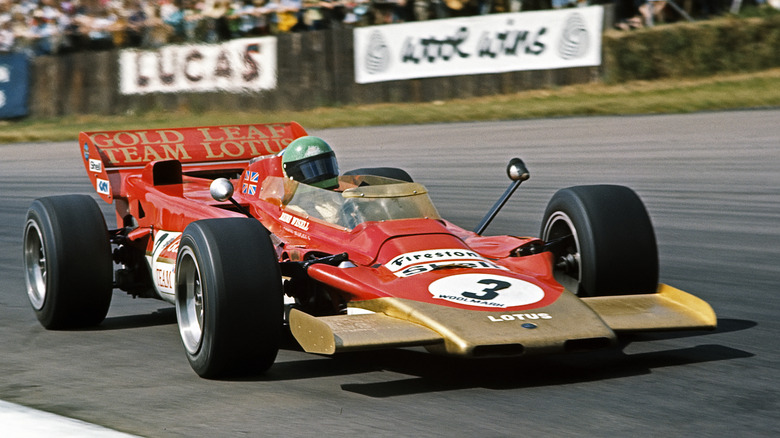The Incredible Turbine Powered Lotus That Nearly Won The Indy 500
In 1967, legendary racing driver Parnelli Jones was positively dominating the Indianapolis 500-Mile Race. With 196 of 200 total laps completed and Jones ahead by nearly a full lap, victory seemed almost inevitable until disaster struck. Of all things, a $6 ball bearing in the car's transmission failed, forcing the driver to coast into the pits. Though the car was repaired as quickly as possible, it was too late — Parnelli finished the race in sixth place.
That recount is interesting enough on its own, but what's truly remarkable was Parnelli's ride. It was the first turbine-powered car to ever run the Indy 500. The brainchild of Andy Granatelli, then-CEO of lubricant giant STP, the Paxton Turbocar was propelled by a Pratt & Whitney ST6B-2 turbine of the type that would be typically found in a small aircraft, coupled to a four-wheel drive system from Ferguson Research.
The Turbocar's tremendous performance in the 1967 race proved beyond a doubt that turbine-powered race cars were worthy of further exploration, which is exactly what Granatelli set out to do ahead of the 1968 event at the Indianapolis Motor Speedway, nicknamed the Brickyard. This time, he would consult with Colin Chapman's Lotus Cars in England, an innovator who had turned the hallowed race upside down a few years earlier by winning with a then-revolutionary rear-engined car.
[Featured image by Andrew Basterfield via Wikimedia Commons | Cropped and scaled | CC BY-SA 2.0]
Another impressive showing marred by technical difficulties
The product of the Granatelli/Lotus collaboration was the Lotus 56, the first-ever turbine-powered Lotus car. Like the car driven by Parnelli Jones one year earlier, the 56 would also take advantage of four-wheel drive's extra traction to harness the turbine's power, this time a slightly different STN 6/76 from Pratt & Whitney that generated approximately 500 horsepower. However, that's where the similarities ended.
Chapman's infatuation with weight and aerodynamics resulted in a different layout for the 56, with the engine behind the driver — as opposed to alongside in the earlier Paxton Turbocar — and a radically narrow, doorstop-like wedge shape.
For the 1968 Indy 500, Granatelli and Lotus decided to campaign not one, but four of the Lotus 56s. During practice sessions, one of the cars piloted by Mike Spence set a new track record of 169.555 mph, so the team knew that it had a formidable contender on its hands. Later in the day, Spence took the wheel of a different Lotus 56 which appeared to be underperforming. Unfortunately, Spence was involved in a crash during his troubleshooting test laps in that second car, one which he didn't survive.
[Featured image by The359 via Wikimedia Commons | Cropped and scaled | CC BY-SA 3.0]
The technology was eventually banned
Despite the devastating loss of Spence, the team continued with the three remaining turbine cars, setting additional records during qualifying. The fastest Lotus 56 turned a lap at 171.953 mph, nearly three mph faster than the quickest piston-engined car to date.
In the actual 1968 race, the lead changed hands several times until lap 175, when a Lotus 56 driven by Joe Leonard gained the lead and stayed there until lap 192. Suddenly, an aggressive bout of acceleration on Leonard's part caused the turbine engine to fail just eight laps short of the finish line. The problem was later diagnosed to be a fuel delivery issue, which allowed a piston-engined car driven by Bobby Unser to win.
For the 1969 Indy 500, Andy Granatelli and his STP team returned with a more conventional racer powered by a Ford V8 and ended up winning — a first for Granatelli in 23 years of trying. Lotus continued to campaign a modified version of the 56, called the 56B (above), in a handful of Formula 1 races with only moderate success. Later, the governing body for open-wheel race cars outlawed not only turbine-powered cars but four-wheel drive cars as well, putting an end to any further development.


